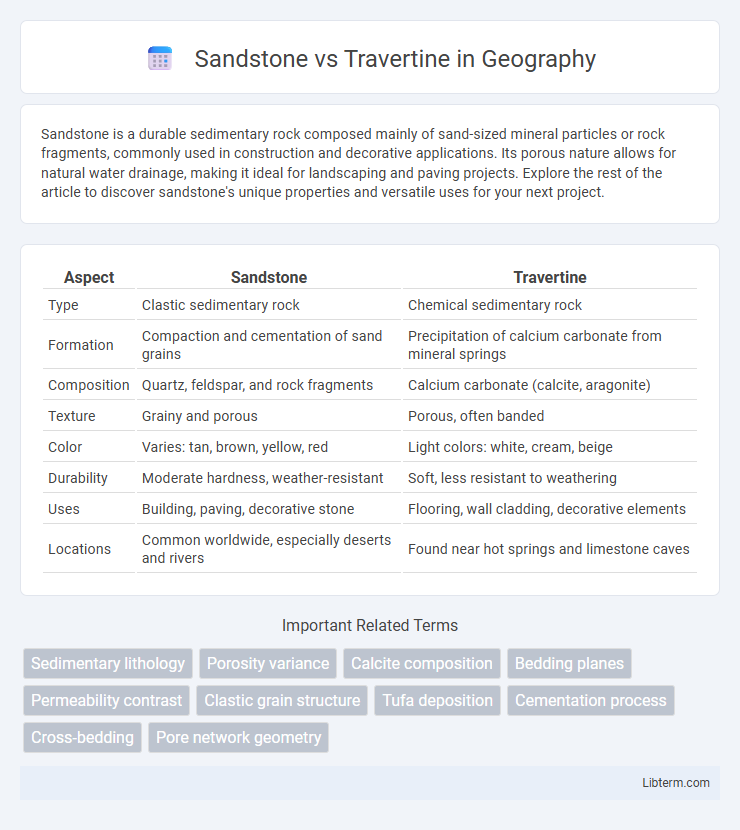Sandstone is a durable sedimentary rock composed mainly of sand-sized mineral particles or rock fragments, commonly used in construction and decorative applications. Its porous nature allows for natural water drainage, making it ideal for landscaping and paving projects. Explore the rest of the article to discover sandstone's unique properties and versatile uses for your next project.
Table of Comparison
| Aspect | Sandstone | Travertine |
|---|---|---|
| Type | Clastic sedimentary rock | Chemical sedimentary rock |
| Formation | Compaction and cementation of sand grains | Precipitation of calcium carbonate from mineral springs |
| Composition | Quartz, feldspar, and rock fragments | Calcium carbonate (calcite, aragonite) |
| Texture | Grainy and porous | Porous, often banded |
| Color | Varies: tan, brown, yellow, red | Light colors: white, cream, beige |
| Durability | Moderate hardness, weather-resistant | Soft, less resistant to weathering |
| Uses | Building, paving, decorative stone | Flooring, wall cladding, decorative elements |
| Locations | Common worldwide, especially deserts and rivers | Found near hot springs and limestone caves |
Introduction to Sandstone and Travertine
Sandstone is a sedimentary rock composed primarily of sand-sized mineral particles or rock fragments, known for its durability and earthy, natural colors ranging from tan to reddish hues. Travertine is a form of limestone deposited by mineral springs, characterized by its fibrous or concentric appearance and a soft, porous texture often found in creamy white, beige, and rusty tones. Both stones are widely used in construction and landscaping, prized for their distinct aesthetics and unique properties.
Geological Formation and Composition
Sandstone forms from cemented sand-sized mineral particles, primarily quartz and feldspar, deposited by water, wind, or ice over millions of years, resulting in a porous and durable sedimentary rock. Travertine develops from the rapid precipitation of calcium carbonate in hot spring or limestone cave environments, characterized by its banded or fibrous texture due to layers of mineral deposits. The distinct geological formation processes and mineral compositions lead to sandstone's granular texture and travertine's smooth, crystalline appearance.
Visual Appeal and Color Variations
Sandstone offers a warm, earthy visual appeal with natural textures and a range of colors from beige and brown to reddish hues, making it ideal for rustic and outdoor settings. Travertine showcases a distinctive porous surface with smooth veining patterns, available in soft neutral tones like cream, ivory, and gold, adding elegance to both interior and exterior spaces. The color variations in both materials allow for versatile design choices, with sandstone providing a rugged charm and travertine delivering a polished, classic aesthetic.
Durability and Strength Comparison
Sandstone, composed mainly of quartz grains, offers moderate durability suitable for indoor applications but is more prone to erosion and weathering compared to travertine. Travertine, a form of limestone with a denser structure, exhibits higher compressive strength and better resistance to wear, making it ideal for high-traffic areas and outdoor use. Both stones require proper sealing to enhance durability, but travertine generally outperforms sandstone in terms of long-term strength and resilience.
Surface Texture and Finish Options
Sandstone offers a naturally grainy and rough surface texture, ideal for rustic or outdoor environments, while travertine presents a smoother, more polished finish with characteristic porous cavities. Sandstone finish options typically include honed, tumbled, or natural cleft, enhancing its rugged appearance, whereas travertine is commonly available in polished, honed, and filled finishes to create elegant, refined surfaces. These textural and finish differences influence durability, slip resistance, and aesthetic suitability for various architectural and landscaping projects.
Installation Process and Maintenance Needs
Sandstone installation requires careful sealing due to its porous nature to prevent moisture absorption, while travertine demands filling its natural pits before sealing for a smooth, durable surface. Sandstone maintenance involves regular resealing and gentle cleaning to avoid surface erosion, whereas travertine needs periodic sealing to protect against stains and acid damage, with routine sweeping to prevent grit scratches. Both stones benefit from pH-neutral cleaners and avoiding harsh chemicals to extend their lifespan and maintain their natural beauty.
Cost Analysis: Sandstone vs Travertine
Sandstone generally costs less than travertine due to its widespread availability and simpler extraction process, with prices ranging from $4 to $10 per square foot compared to travertine's $5 to $15 per square foot. Installation expenses can be higher for travertine because of its porous nature requiring sealing and maintenance to prevent staining and erosion. Longevity and durability impact overall cost-effectiveness, as sandstone can be more prone to weathering while travertine offers stronger resistance but demands higher upfront investment.
Best Applications for Each Stone
Sandstone excels in outdoor applications such as patios, walkways, and garden walls due to its durability and resistance to weathering. Travertine is ideal for indoor flooring, bathroom tiles, and pool surrounds because of its elegant appearance and non-slip surface. Both stones offer unique textures and colors, making them suitable for specific design aesthetics and functional needs.
Environmental Impact and Sustainability
Sandstone, with its abundant natural deposits and minimal chemical processing, tends to have a lower environmental impact compared to travertine, which often requires more intensive quarrying and treatment to stabilize its porous structure. Travertine's formation in geothermal environments means its extraction can disrupt unique ecosystems and water sources, raising sustainability concerns. Choosing sandstone sourced from responsibly managed quarries can significantly reduce carbon footprints and support eco-friendly building practices.
Choosing the Right Stone for Your Project
Selecting between sandstone and travertine depends on the project's requirements for durability, texture, and aesthetic appeal. Sandstone offers a coarse, grainy texture with excellent weather resistance, ideal for outdoor use and high-traffic areas. Travertine provides a smoother surface with natural pits and veins, perfect for elegant indoor flooring and decorative features that require a refined appearance.
Sandstone Infographic

 libterm.com
libterm.com